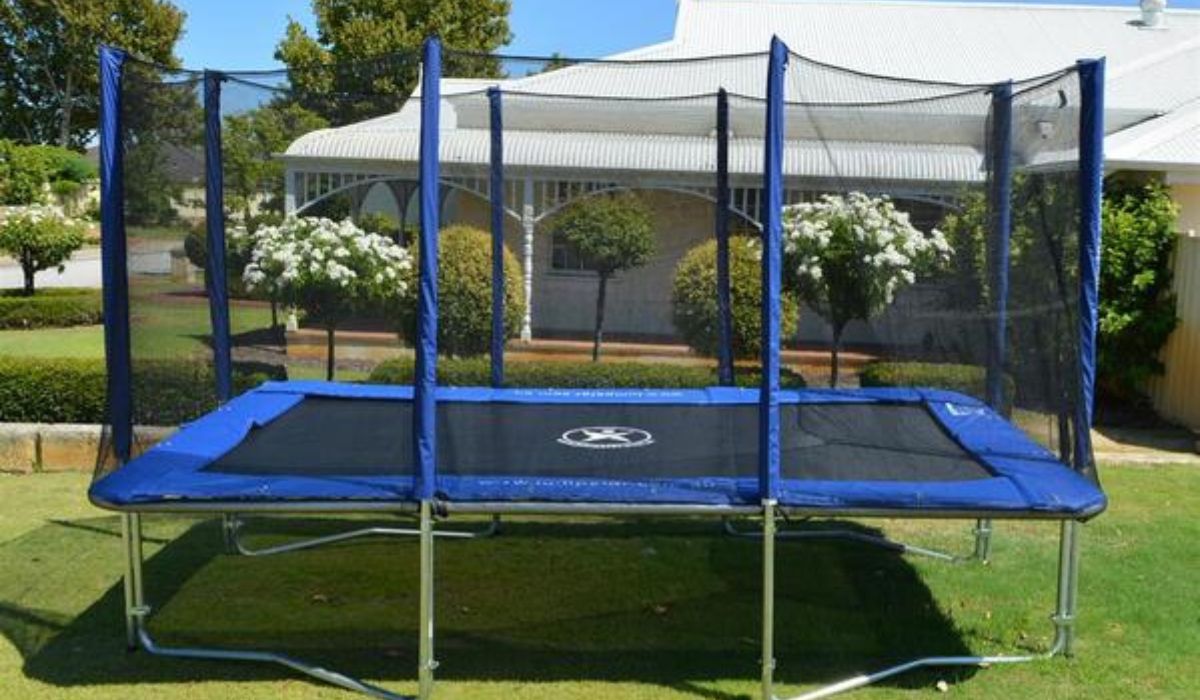Since their inception in the early 20th century, trampolines have undergone several improvements. Trampolines have made the transition from their original purpose in the circus and gymnastics to a fun pastime for kids and adults alike trampoline, in their own backyards. In this post, we will delve into the fascinating world of trampolines, including their uses, risks, types, how to pick the proper one, assembly, enclosures, games, upkeep, and care.
Trampolines have a durable cloth jumping mat stretched over a steel frame with coiled springs, making them a multipurpose piece of equipment. The trampoline’s springs create a bouncing effect when someone jumps on it, sending them flying. It’s a fun way to get some exercise while also having a thrilling time. Because they are a great way to get some exercise while having a good time, trampolines have become increasingly popular.
There’s a lot of interesting backstory to trampolines. In the 1930s, George Nissen and Larry Griswold took cues from circus safety netting and pioneered the design. Trampolines have evolved into a fun and useful fitness tool for people of all ages as they have grown more user-friendly and widely available.
Benefits of Trampoline Exercises
- Physical fitness and cardiovascular health: Trampoline jumping is a great low-impact aerobic activity that has been shown to raise heart rate, promote blood flow, and boost cardiovascular endurance.
- Improved balance and coordination: Trampolining is great for your balance, coordination, and spatial awareness because of the continual adjustments and proprioceptive feedback you receive.
- Strengthening of muscles and bones: Multiple muscle groups, including the abdominals, legs, and arms, are used in the jumping motion. Muscles are strengthened, bone density is increased, and musculoskeletal health is enhanced as a result of this activity.
Safety Precautions and Guidelines
While there are many advantages to using a trampoline, safety must always come first to avoid injuries. Important rules and safety considerations are outlined below.
- Proper installation and maintenance: Make sure the trampoline is put together properly by following the directions provided. Maintaining and inspecting a trampoline on a regular basis will help you spot problems and wear and tear.
- Supervision and age restrictions: The use of the trampolines by children requires adult supervision. Only trampolines made for children’s ages or older should be used around kids.
- Safe jumping techniques: Instruct students in safe jumping practices such as maintaining a neutral spine, landing on the toes, and landing with slightly bent knees.
Types of Trampolines
You may find trampolines in a wide range of sizes and shapes to meet your specific requirements. Here are the top three categories:
- Round trampolines: These trampolines are commonly used for fun and exercise in the backyard. They’re great for parties because their bounce is consistent.
- Rectangular trampolines: Competitive sports and gymnastics training typically make use of rectangular trampolines. The leaping surface is larger and more manageable, and the bounce is greater.
- Mini trampolines: Mini trampolines, also known as rebounders, are ideal for usage within the home due to their compact size and low noise levels. Low-impact aerobic exercises benefit greatly from their utilization.
Choosing the Right Trampoline
Here are some things to keep in mind while shopping for a trampoline:
- Size and space: Consider the layout of your backyard and pick a trampolines that will fit without having to move anything around.
- Weight capacity and durability: Verify the trampoline’s weight limit to make sure it can support the jumpers’ combined weight. Choose components that can stand up to the elements.
- Additional features and accessories: Included features may include cages, ladders, and even basketball hoops on select trampolines. Depending on your needs and budget, you might want to think about these supplementary options.
Setting Up a Trampoline
Setup and installation must be done correctly to ensure safety and peak performance. To properly install your trampolines, please do as follows:
- Selecting an appropriate location: Pick a level spot in the yard that is free of obstacles like trees, fences, and the like. Make sure the area around the trampoline is spacious enough.
- Assembling the trampoline: The trampoline frame, springs, and jumping mat must be assembled in accordance with the manufacturer’s specific instructions.
- Ensuring proper anchoring and stability: Make sure the trampolines stays there by using the stakes or ground anchors that came with it. This ensures that it won’t topple over in the middle of use or if the wind picks up.
Trampoline Safety Enclosures
Trampoline safety enclosures, often called nets or fences, are designed to keep kids safe as they jump. What you must know about them is as follows:
- Purpose and benefits of enclosures: Trampoline users are less likely to sustain injuries when using a trampoline that has a safety cage installed. Parents and caregivers may rest easy knowing their children are safe.
- Types of enclosures available:
- Enclosures can either be fixed to the trampoline’s framework or hung from the ceiling using poles. Pick a style that works with the trampoline you have.
- Installation and maintenance tips: Tips for setup and upkeep include firmly attaching the enclosure to the trampoline and making sure it is level. Always keep an eye out for holes and rips, and fix them right once if you find any.
Fun and Creative Trampoline Activities
There is no end to the imaginative and entertaining things that can be done on a trampoline. In order to get the most out of your trampoline, consider the following:
- Jumping and bouncing games: Popcorn-inspired bouncing games can be played in the style of Simon Says or Dodgeball.
- Trampoline fitness workouts: Try out some high-intensity exercises like trampoline-specific dance routines, trampoline-based aerobics, or interval training.
- Trampoline sports and competitions: Investigate activities that can be adapted on the trampoline, such as basketball, volleyball, or gymnastics routines. Throw a casual competition for your friends and family.
Maintenance and Care
A trampoline’s durability and security depend on regular maintenance. Here are some suggestions for upkeep:
- Regular cleaning and inspections: Clean the trampoline mat of any leaves, dirt, or other debris. Check for damage or wear on the mat, springs, and frame.
- Repairing and replacing damaged parts: Maintaining the trampoline’s safety and functionality requires prompt attention to any worn or broken components.
- Seasonal storage tips: If you live in a location with harsh winters or inclement weather, you may want to take your trampoline apart and store it away while it’s not in use.
Conclusion
Invigorate your body and have a blast in the fresh air with the help of a trampoline. They are good for your cardiovascular fitness, mental acuity, and even your balance and coordination. However, trampoline safety must always come first. You can make sure everyone has a good time jumping on the trampoline by following the installation instructions, taking the necessary safety measures, and selecting the best trampoline for your purposes.











